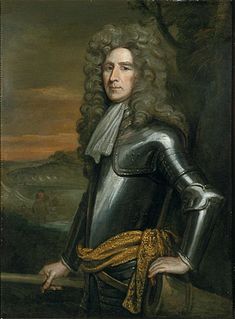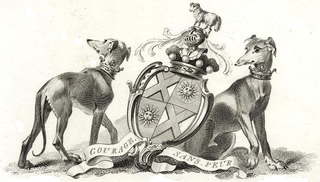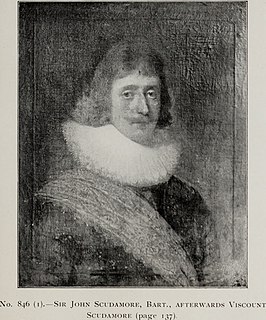
Viscount Hereford is the oldest and only extant viscountcy in the Peerage of England, making the holder the Premier Viscount of England. The title was created in 1550 for Walter Devereux, 10th Baron Ferrers of Chartley.

Marquess Townshend is a title in the Peerage of Great Britain held by the Townshend family of Raynham Hall in Norfolk. This family descends from Roger Townshend, who in 1617 was created a baronet, of Raynham in the County of Norfolk, in the Baronetage of England. He later represented Orford and Norfolk in the House of Commons. His younger son, the third Baronet, played an important role in the restoration of the monarchy after the Civil War and was also Member of Parliament for Norfolk. In 1661 he was created Baron Townshend, of Lynn Regis in the County of Norfolk, and in 1682 he was further honoured when he was made Viscount Townshend, of Raynham in the County of Norfolk. Both titles were in the Peerage of England.

Earl of Romney is a title that has been created twice.

Earl of Rosse is a title that has been created twice in the Peerage of Ireland, both times for the Parsons family.

Earl of Verulam is a title in the Peerage of the United Kingdom. It was created in 1815 for James Grimston, 4th Viscount Grimston. He was made Viscount Grimston at the same time. Verulam had previously represented St Albans in the House of Commons. In 1808 he had also succeeded his maternal cousin as tenth Lord Forrester. He was succeeded by his son, the second Earl. He was a Tory politician and held minor office in the first two governments of the Earl of Derby. His son, the third Earl, represented St Albans in Parliament as a Conservative. His grandson, the sixth Earl was nominated to the traditionally safe seat of St Albans for the party. As of 2017 the titles are held by his son, the seventh Earl, who succeeded in 1973.

Viscount Gage, of Castle Island in the County of Kerry of the Kingdom of Ireland, is a title in the Peerage of Ireland. It was created in 1720 for Thomas Gage, along with the subsidiary title of Baron Gage, of Castlebar in the County of Mayo, also in the Peerage of Ireland. In 1744 he also succeeded his cousin as eighth Baronet, of Firle Place. The titles remain united. The Gage family descends from John Gage, who was created a baronet, of Firle Place in the County of Sussex, in the Baronetage of England on 26 March 1622. His great-grandson, the seventh Baronet, represented Seaford in Parliament. He was succeeded by his first cousin, Thomas Gage, 1st Viscount Gage, the eighth Baronet. He sat as a Member of Parliament for Minehead and Tewkesbury and also served as Governor of Barbados. In 1720, 24 years before succeeding in the baronetcy, he was raised to the Peerage of Ireland as Baron Gage and Viscount Gage. His second son was the military commander the Hon. Thomas Gage.

Baron Somers, of Evesham in the County of Worcester, is a title that has been created twice. The title was first created in the Peerage of England in 1697 for Sir John Somers, so that he could sit in the House of Lords and serve as Lord Chancellor. The title became extinct on Lord Somers' death in 1716. His sister and co-heiress, Mary Somers, married Charles Cocks, a member of a prominent Worcestershire family. Their grandson Charles Cocks represented Reigate in Parliament from 1747 to 1784, and was created a baronet, of Dumbleton in the County of Gloucester, in the Baronetage of Great Britain in 1772. In 1784 the barony held by his great-uncle was revived when he was made Baron Somers, of Evesham in the County of Worcester, in the Peerage of Great Britain.

Baron Farnham, of Farnham in the County of Cavan, is a title in the Peerage of Ireland. It was created in 1756 for John Maxwell, who had previously represented Cavan Borough in the Irish House of Commons. John Maxwell's son, the second Baron, was created Viscount Farnham in 1760 and Earl of Farnham in 1763. Both titles were in the Peerage of Ireland but became extinct when he died childless in 1779. His brother and successor, the third Baron, was again created Viscount Farnham in 1781 and Earl of Farnham in 1785. These titles were also in the Peerage of Ireland. His son, the second Earl, sat in the House of Lords as an Irish Representative Peer from 1816 to 1823. However, he had no children and on his death in 1823 the viscountcy and earldom became extinct.

Charles FitzRoy-Scudamore was a British politician who sat in the House of Commons for 49 years from 1733 to 1782.
Holme Lacy is a village in the English county of Herefordshire. The population of the civil parish was 466 at the 2011 Census.

John Scudamore, was the eldest son of William Scudamore and Ursula Pakington, the daughter of Sir John Pakington, but due to his father's early death was a ward of Sir James Croft of Croft Castle, Herefordshire, whose daughter Eleanor Croft he had married by 1563.

John Scudamore, 1st Viscount Scudamore was an English diplomat and politician who sat in the House of Commons at various times between 1621 and 1629. In 1628 he was created Viscount Scudamore in the Irish peerage.

Sir James Scudamore (1568–1619) was a gentleman usher at the court of Queen Elizabeth I. Born at Holme Lacy, Herefordshire, he was the eldest son of John Scudamore, Custos Rotulorum of Herefordshire and his first wife Eleanor Croft, daughter of former Lord Deputy of Ireland James Croft. He would assume that title in 1616, and remained Custos Rotulorum for two years until his own death in 1619. Scudamore was respected for his tilting skill and his embodiment of the ideals of chivalry.

James Scudamore was an English politician who sat in the House of Commons at various times between 1642 and 1668.

James Scudamore, 3rd Viscount Scudamore, was an English landowner and Tory politician who sat in the House of Commons from 1705 to 1716.
Sir Giles Brydges, 1st Baronet was an English politician who sat in the House of Commons at various times between 1621 and 1629.
There have been two baronetcies created for members of the Scudamore family, both in the Baronetage of England. Both creations are extinct.
John Scudamore, 2nd Viscount Scudamore DL, was an English landowner and politician.
Frances Scudamore, Duchess of Beaufort (1711–1750) was a noblewoman and heiress. The only child of James Scudamore, 3rd Viscount Scudamore, she was his sole heir upon his death in 1716. Her mother, Frances née Digby, had introduced the family to Alexander Pope. Frances married, on 28 June 1729, Henry Somerset, 3rd Duke of Beaufort, who the following year took the surname Scudamore by Act of Parliament. The marriage was not a happy one, leading the Duchess to have an affair with William Talbot, 2nd Baron Talbot. In 1742, the Duke filed for divorce due to this affair; the Duchess countersued, claiming that the Duke was impotent. When the Duke disproved her claim before court-appointed examiners, the divorce was granted in March 1743, followed by the Duke suing Lord Talbot for damages.
The Scudamorefamily is an English Noble family of Anglo-Norman origins. The family settled in Herefordshire before the Norman Conquest, at two seats, Holme Lacy and Kentchurch Court, before lines moved to Devon, Somerset and Derbyshire. The family first gained prominence in the 15th and 16th centuries, before becoming ennobled as Viscount Scudamore and Baron Dromore in the 17th century, and were granted two baronetcies in 1620 and 1644. The family married into several noble dynasties including the Cecil, Beaufort, and Howard families, and became ancestors to the Earls of Chesterfield.













